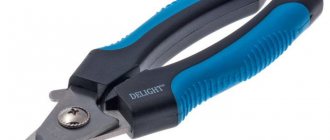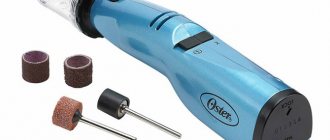An attentive person will immediately notice that a four-legged pet is sick or feels unwell, and will try to help his beloved cat. Before you panic and take your cat to the vet, we recommend taking his temperature. The result will show whether it is worth rushing to the veterinary clinic or whether you can take a wait-and-see approach.
The only reliable way to measure an animal’s thermometry is rectal.
The photo below shows an insufficiently reliable method of measuring temperature under the armpit, which shows the temperature with an error.
Veterinarians consider other methods to be uninformative or unreliable.
Why does a cat's body temperature change?
Normal indicators of the thermal state of a cat’s body are in the range of 38 – 39.5 degrees. In young animals, the limit is up to 39.3. Any deviations upward or downward are signs of an emerging disease.
| Normal in adults | Invalid values for adults | Normal for newborn kittens | Normal for kittens up to 7 months |
| 37.5 – 39°C | less than 37°C more than 40.5°C | 34.7 - 37.2°C | 36.5 - 37.0 °C 39 - 39.1 °C |
Data may fluctuate depending on the following factors:
- Physiology. During sleep, degrees drop due to reduced energy production. And, conversely, they increase during active games or after eating. Pregnant and lactating cats may have elevated levels.
- Age. In kittens up to 3-4 months of age, heat transfer is just beginning to develop. Therefore, the temperature deviates from the norm and is usually higher. In older cats, metabolic processes slow down, and indicators may be below normal. But this is not a pathology.
- Times of Day. It has been noted that in the evening the temperature of cats is slightly higher than in the morning.
- Stress. Sometimes in some animals the degrees rise to 39.5 during the measurement itself, as a reaction to stress.
Why measure your sugar level?
Self-monitoring of glucose will allow you to:
- determine the effectiveness of medications at night, after meals and between meals;
- calculate the optimal dose of insulin and dosage of medications;
- adjust nutrition and physical activity;
- assess the dynamics of the disease;
- ensure driving safety;
- prevent the development of diabetic crisis, hypoglycemia and hyperglycemia.
It should be noted that self-monitoring cannot replace laboratory diagnostics. Therefore, you should visit the clinic every month for a blood test.
Types of thermometers
There are several types of temperature measuring devices that are most often used in cats:
- mercury thermometer;
- electronic rectal;
- electronic universal.
A mercury thermometer is available, accurate, but easily damaged. If the animal is aggressive towards thermometry, the device may break during the procedure.
The electronic device is easy to use, safe, and has a small error of 0.1-0.5 degrees. To find out the data, it will take from 10 to 60 seconds (depending on the model).
It is preferable to measure temperature with an electronic thermometer, as it measures faster and therefore causes less discomfort to the animal. It is taken out at a signal. Regular mercury is measured for 5 minutes. Not every pet can sit still for that amount of time.
There are more expensive options - infrared, to measure in the ear. Collects heat impulses from the ear canal. The disadvantages of the device include its high price. Also, if you have ear disease (otitis media, ear mites), the readings may be inaccurate.
An option such as a pyrometer, which non-contactly measures the temperature in the forehead area, is not suitable for animals with fur.
Measurement methods
A mistake in measuring a cat’s temperature can cost the animal’s health and cause problems with treatment for the owner.
You can determine the temperature level at home using the following devices:
- rectal thermometer - an electronic device that responds instantly and shows accurate results;
- electronic thermometer - often used as the main device for determining the temperature of pets;
- mercury thermometer - used in extreme cases and gives readings after 5 minutes.
According to experts, it is recommended to refrain from measuring temperature non-rectally. Sometimes you can do without a thermometer and use other available methods that will be simpler but less accurate. In this way, it will not be possible to accurately determine the cat’s temperature, but you can find out about possible disorders in the pet’s body.
Critical indicators
A cat's body temperature can be either critically elevated (hyperthermia) or reduced (hypothermia).
Hyperthermia is said to occur when readings are above 39.5°C.
If your cat has hyperthermia, the signs are as follows:
- chills;
- hot ears;
- loss of appetite;
- weakness;
- thirst.
The causes of hyperthermia are heat stroke (during prolonged stay in a poorly ventilated room in hot weather), viral, bacterial infections, worms and other cat diseases.
Fever is dangerous due to the following consequences:
- 40.5 °C – danger of dehydration and heart failure.
- 41.1 °C – threatens with cerebral edema, disruption of the heart, lungs, intestinal bleeding, and digestive disorders.
Hypothermia is a consequence of hypothermia, illness, or the use of narcotic drugs. It has different degrees of severity. At 36.7–37.7 °C it is considered mild, at 33 °C it is considered critical.
Infrared contactless
Having overcome all the disadvantages of the above thermometers, to the delight of people there are non-contact infrared thermometers. The principle of their operation is that the thermometer sensor detects infrared waves emanating from the human body, from objects, food, etc.
Advantages:
- safety (does not contain glass and mercury, is not a carrier of infections),
- measurement time – several seconds,
- the built-in memory in the thermometer allows you to track temperature dynamics,
- ease of use – even a child or an elderly person can understand the measurement rules,
- a wide range of measured temperatures, which allows you to measure the temperature of other objects (food, drinks, water in the bath, air in the room, animal),
- The backlight allows you to measure body temperature even in the dark (for example, a child without waking him up, since it does not require contact with the skin).
Should you see a doctor?
If the temperature is caused not by illness, but by other factors, then it goes away quickly. Accordingly, if there is no improvement, then you need to go to the veterinarian. Sometimes the cat has to be left under the supervision of doctors if the situation is especially difficult: it requires medication and constant care.
Even if the fever has passed, but there are reasons to worry, it is worth taking the animal to the veterinarian. Preventing the development of complications is much better than encountering them later.
If, apart from an elevated temperature, no alarming symptoms are observed, it is enough to measure it every few hours to make sure that it does not increase further. If it rises, then decreases, then rises again by whole degrees - you should go to the doctor as soon as possible. High temperature within certain limits is not dangerous in itself; it only indicates that the body is resisting something. But dehydration or convulsions resulting from it can be dangerous.
If you treat your cat carefully, measure the temperature every time there are alarming symptoms, and take action quickly if necessary, then illnesses usually go away easier and faster.
Additional functions of the meter
Typically, the device only measures the blood glucose concentration using a preset method. The kit includes the device itself, a set of test strips for the first time and a lancet for piercing the skin.
More expensive models come with statistical options, including separating measurements taken before and after meals. This is convenient for those who forget to fill out self-monitoring diaries.
A glucometer for an elderly or visually impaired person may have a voice assistant or a backlit display. The additional expense in this case is justified. You can also invest in an option with an auto-lancer, because not everyone has the fortitude to do it manually.
Options such as the ability to communicate with a computer or smartphone, the presence of extra control buttons and a timer are unimportant. Some sugar meters also analyze cholesterol levels.
What help to provide
A common mistake is to give a cat antipyretics intended for humans. Under no circumstances should you do this! Before giving medicine to an animal, you should at least call your veterinarian and ask his advice.
You can try to alleviate your cat's condition using the following measures:
- ensure the room is ventilated;
- apply ice wrapped in a cloth or a damp towel to the groin to reduce the temperature a little;
- Place more water next to her bed.
If time passes and the condition does not improve, contact your veterinarian. If this cannot be done right away, then you need to:
- wipe the cat’s paws with a damp cloth once every half hour (but do not wet the fur!);
- if your pet has diarrhea or vomiting, he needs Regidron solution, replacing solid food with broth and more water.
How to choose the right glucometer
You can see many models on the market. Equally high-quality devices differ in the degree of convenience for a particular user. You can understand which glucometer is best to buy for your home by answering a few questions:
- Which type of device is most convenient for you?
- Does the required blood volume matter? For the elderly, children and especially sensitive people, the depth of the puncture is important.
- Is measurement time important? Faster ones cost more, but not everyone needs them.
- What test strips are available in pharmacies near you?
- Is additional plasma calibration required? In simpler devices it is carried out through capillary blood.
- How much memory is needed? This determines how many last measurements can be recorded.
It is important to decide whether additional features are needed. Modern sugar meters can have a lot of them. But their presence is not necessary.
Photometric glucometers
These devices read the change in color of a test strip onto which the patient's blood is applied. Such strips are coated with a reagent containing glucose oxidase. It gives specific responses to a particular level of glucose concentration, coloring the strip in the appropriate color.
You don't have to compare colors yourself. The scale is already stored in the device's memory. When a test strip is inserted into it, it compares its color with the values on this scale and produces a numerical result.
Such devices are easy to use, but quickly break down. In addition, their optical system is so fragile that there is a high probability of breaking the glucometer during operation. And if the lens becomes cloudy, the results may be distorted.
Causes of fever in a cat
A high temperature in a pet does not always mean that urgent measures are needed, so it is first of all important to establish its cause. Cases in which everything will probably soon pass without consequences:
- Stress due to having to be in a public place - for example, at an exhibition; or from moving, guests or other events that greatly agitated the cat.
- The pet is recovering from dehydration, overheating or other similar external factors. If their effects are eliminated, he should soon return to normal.
- A temporary increase in temperature is observed after sterilization in cats and castration in cats - this is a common condition in such a situation.
- Prolonged physical activity also causes a slight increase in the animal's temperature.
- Physiological processes activated due to pregnancy - if it is not too high and does not last too long, there is no need to worry.
But there are also situations in which fever indicates serious problems and turns out to be one of the symptoms:
- Viral disease - in this case, sneezing and lacrimation are observed along with it.
- Infectious disease - it is characterized by lethargy and lack of appetite, weak urination.
- Oncology – cough, vomiting, shortness of breath. In the early stages it may hardly manifest itself.











